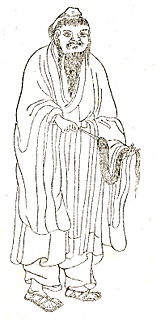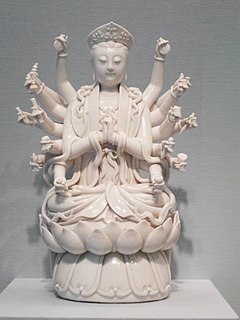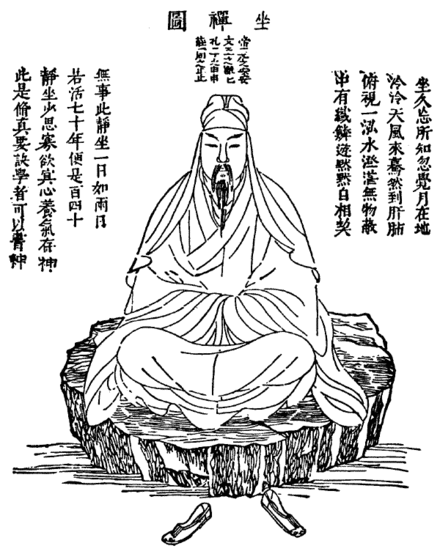
Taoism, or Daoism, is a religious or philosophical tradition of Chinese origin which emphasizes living in harmony with the Tao. The Tao is a fundamental idea in most Chinese philosophical schools; in Taoism, however, it denotes the principle that is the source, pattern and substance of everything that exists. Taoism differs from Confucianism by not emphasizing rigid rituals and social order, but is similar in the sense that it is a teaching about the various disciplines for achieving "perfection" by becoming one with the unplanned rhythms of the universe called "the way" or "dao". Taoist ethics vary depending on the particular school, but in general tend to emphasize wu wei, "naturalness", simplicity, spontaneity, and the Three Treasures: 慈 "compassion", 儉 "frugality", and 不敢為天下先 "humility".
Daozang, meaning "Taoist Canon", consists of around 1,400 texts that were collected c. 400. They were collected by Taoist monks of the period in an attempt to bring together all of the teachings of Taoism, including all the commentaries and expositions of the various masters from the original teachings found in the Tao Te Ching and Zhuangzi. It was split into Three Grottoes, which mirrors the Buddhist Tripitaka division. These three divisions were based on the main focus of Taoism in Southern China during the time it was made, namely; meditation, ritual, and exorcism.
The Three Treasures or Three Jewels are theoretical cornerstones in traditional Chinese medicine and practices such as Neidan, Qigong, and T'ai chi. They are also known as Jing Qi Shen. Despeux summarizes.
Jing, qi, and shen are three of the main notions shared by Taoism and Chinese culture alike. They are often referred to as the Three Treasures, an expression that immediately reveals their importance and the close connection among them. The ideas and practices associated with each term, and with the three terms as a whole, are complex and vary considerably in different contexts and historical periods. (2008:562)
Neigong, also spelled nei kung, neigung, or nae gong, refers to any of a set of Chinese breathing, meditation and spiritual practice disciplines associated with Daoism and especially the Chinese martial arts. Neigong practice is normally associated with the so-called "soft style", "internal" or neijia 內家 Chinese martial arts, as opposed to the category known as waigong 外功 or "external skill" which is historically associated with shaolinquan or the so-called "hard style", "external" or wàijiā 外家 Chinese martial arts. Both have many different schools, disciplines and practices and historically there has been mutual influence between the two and distinguishing precisely between them differs from school to school.
The Guanzi is an ancient Chinese political and philosophical text that is named for and traditionally attributed to the 7th century BCE statesman Guan Zhong, who served as Prime Minister to Duke Huan of Qi. At over 135,000 characters long, the Guanzi is one of the longest early Chinese philosophical texts. The Han Dynasty scholar Liu Xiang edited the received Guanzi text circa 26 BCE. It contains a wide variety of material from many different authors over several successive centuries, largely associated with the 4th century BCE Jixia Academy in the Qi capital of Linzi, but much of it may actually not have been compiled until after the Han Feizi (though the Neiye are thought to have inluenced the Zhuanghi.

The Northern Celestial Masters type of the Way of the Celestial Master Daoist movement existed in the north of China during the Southern and Northern Dynasties. The Northern Celestial Masters were a continuation of the Way of the Celestial Masters as it had been practiced in Sichuan province by Zhang Lu and his followers. After the community was forced to relocate in 215 CE, a group of Celestial Masters established themselves in Northern China. Kou Qianzhi, from a family who followed the Celestial Master, brought a new version of Celestial Master Daoism to the Northern Wei. The Northern Wei government embraced his form of Daoism and established it as the state religion, thereby creating a new Daoist theocracy that lasted until 450 CE. The arrival of Buddhism had great influence on the Northern Celestial Masters, bringing monasticism and influencing the diet of practitioners. Art produced in areas dominated by the Northern Celestial Masters also began to show Buddhist influence. When the theocracy collapsed, many Daoists fled to Louguan, which quickly became an important religious center. The Northern Celestial Masters survived as a distinct school at Louguan until the late 7th century CE, when they became integrated into the wider Daoist movement.
The history of Taoism stretches throughout Chinese history. Originating in prehistoric China, it has exerted a powerful influence over Chinese culture throughout the ages. Taoism evolved in response to changing times, with its doctrine and associated practices being revised and refined. The acceptance of Taoism by the ruling class has waxed and waned, alternately enjoying periods of favor and rejection. Most recently, Taoism has emerged from a period of suppression and is undergoing a revival in China.
The Qingjing Jing is an anonymous Tang Dynasty Daoist classic that combines philosophical themes from the Dao De Jing with the logical presentation of Buddhist texts and a literary form reminiscent of the Heart Sutra. It instructs students of the Dao to practice the elimination of desire in order to cultivate spiritual purity and stillness.

The Xishengjing is a late 5th century CE Daoist text with provenance at the Louguan 樓觀 "Tiered Abbey" of The Northern Celestial Masters. According to Daoist tradition, Louguan was near where the legendary Laozi 老子 transmitted the Daodejing to the Guardian of the Pass Yin Xi 尹喜. The Xishengjing allegedly records the Daoist principles that Laozi taught Yin Xi before he departed west to India.
Zuowang is a classic Daoist meditation technique, described as, "a state of deep trance or intense absorption, during which no trace of ego-identity is felt and only the underlying cosmic current of the Dao is perceived as real." According to Louis Komjathy, this is one term for Daoist apophatic meditation, which also goes by various names in the Daoist literature such as "quiet sitting", "guarding the one", "fasting the heartmind" and "embracing simplicity".

The Zuowanglun or Zuowang lun is a Daoist meditation text that was written by the Shangqing School patriarch Sima Chengzhen (647–735). Daoism incorporated many Buddhist practices during the Tang Dynasty (618–907), and the Zuowanglun combined meditation techniques from Daoism and Buddhism.
The Xiaodao Lun is an anti-Daoist polemic written in 570 for the Emperor Wu of Northern Zhou (543–578) by the Buddhist courtier Zhen Luan. After holding several inconclusive debates in the court, Emperor Wu commissioned the Xiaodao Lun as one of two reports examining the suitability of sponsoring either Buddhism or Daoism as a state religion for the Northern Zhou dynasty, with a view towards unifying China. The Xiaodao Lun mocked Daoist practices, accused Daoists of plagiarizing Buddhist texts, and portrayed the religion as dangerous to social stability. Its advice was disregarded by the Emperor, who supported the preservation of Daoism, but his dynasty was ultimately short-lived. Zhen Luan's Xiaodao Lun is preserved in the Chinese Buddhist canon and is consulted for its quotations of Daoist texts that have not been preserved until today.
Heshang Gong was a reclusive hermit from the 1st century CE who wrote a commentary on Laozi's Dao De Jing. Little is known about the life of Heshang Gong; however the impact of his writing is extensive in regards to the understanding and translation of the Dao De Jing, and is considered one of the earliest proponents of Daoist meditative practices which cultivate the “three treasures” of vitality, energy, and spirit, and the "dual cultivation" of spiritual nature and life-and-destiny.

The c. 350 BCE Neiye 內業 or Inward Training is the oldest Chinese received text describing Daoist breath meditation techniques and qi circulation. After the Guanzi political and philosophical compendium included the Neiye around the 2nd century BCE, it was seldom mentioned by Chinese scholars until the 20th century, when it was reevaluated as a "proto-Daoist" text that clearly influenced the Daode jing, Zhuangzi, and other classics. Neiye traditions also influenced Chinese thought and culture. For instance, it had the first references to cultivating the life forces jing "essence", qi "vital energy", and shen "spirit", which later became a fundamental concept in Daoist Neidan "internal alchemy", as well as the Three Treasures in traditional Chinese medicine.

Taoist philosophy also known as Taology refers to the various philosophical currents of Taoism, a tradition of Chinese origin which emphasizes living in harmony with the Tao. The Tao is a mysterious and deep principle that is the source, pattern and substance of the entire universe.

Chu is a Daoist name used for various religious practices including communal chu (Kitchen) banquet rituals in Way of the Celestial Masters liturgy, the legendary xingchu associated with Daoist xian, and wuchu representing the wuzang in neidan meditation techniques.

The roles of women in Taoism have differed from the traditional patriarchy over women in ancient and imperial China. Chinese women had special importance in some Taoist schools that recognized their transcendental abilities to communicate with deities, who frequently granted women with revealed texts and scriptures. Women first came to prominence in the Highest Clarity School, which was founded in the 4th century by a woman, Wei Huacun. The Tang dynasty (618-907) was a highpoint for the importance of Daoist women, when one-third of the Shangqing clergy were women, including many aristocratic Daoist nuns. The number of Daoist women decreased until the 12th century when the Complete Perfection School, which ordained Sun Bu'er as the only woman among its original disciples, put women in positions of power. In the 18th and 19th centuries, women Daoists practiced and discussed nüdan, involving gender-specific practices of breath meditation and visualization. Furthermore, Daoist divinities and cults have long traditions in China, for example, the Queen Mother of the West, the patron of xian immortality, He Xiangu, one of the Eight Immortals, and Mazu, the protectress of sailors and fishermen.






















